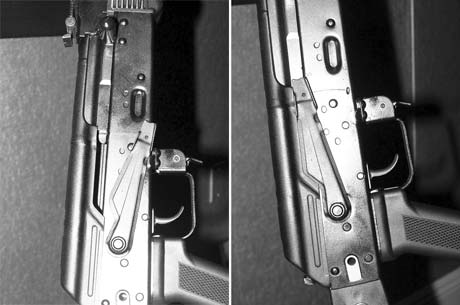 |
|
| Issue #116 • March/April, 2009 |
One reader writes to ask if military surplus rifles are still a good idea for hunting, recreational shooting, and all around backwoods use.
The answer is more complicated than the question. A relevant answer encompassing modern arms has to include commercial “clones” of military rifles, as well as genuine military surplus.
|
When I was a fledgling shooter in the 1950s, you couldn’t get brand new military-style rifles the way you can today; if you wanted military, what you got was military surplus, from our country or others. The Director of Civilian Marksmanship controlled the release of our country’s leftover, obsolete bolt action and semiautomatic firearms. I was still a kid when the National Rifle Association (NRA) announced the availability of light, handy .30 caliber M1 carbines for about $35 apiece. Guys who were around before my time proudly showed me ex-GI 1911 and 1911A1 .45 caliber pistols that they’d purchased for around $17 through the NRA.
It’s a tradition that goes back through at least three centuries. There were private citizens on the Western frontier who carried trapdoor Springfield .45/70 single-shots like the Army used then. After the adoption of the Springfield .30-06 in 1903, leftover Krag-Jorgensen rifles of the Spanish-American War period were released for sale cheap to the public, and to this day in corners of backwoods America, you’ll find men hunting deer with a .30-40 Krag that’s been handed down through the family. The Krag was famous for its smooth-as-butter bolt action. The Cavalry carbine version was already “sporterized,” with a stock like a hunting rifle’s and a short barrel that was handy in the woods.
By the end of WWI, a generation of Americans had been habituated to the fine Springfield ’03 rifle, and to its rugged American Enfield counterpart, the P-14. Springfield rifles were available to the public then, and became the mark of the discriminating outdoorsman, usually finely customized by a gunsmith house such as Griffin & Howe. Many returning doughboys found their souvenir German Mausers could also be fashioned into superb hunting rifles.
It was the post-WWII era, however, that was the heyday of what became known as “sporterized” military rifles. A now “obsolete” Springfield could be had for $29.95, and one of the various Mausers for the same or less. The British Lee-Enfield sold for $19.95 or less in clunky Mark III or Mark IV infantry rifle trim, and for only $25 for the handsome little Jungle Carbine version.
The Jungle Carbine in particular captured the imagination of hunters. It already had a sporter-style stock, and a short barrel just right for woods hunting. The sportsman probably wouldn’t need all 10 rounds in the distinctive magazine that protruded in front of the trigger guard, but the SMLE (short magazine Lee-Enfield) had a super fast bolt action and fired the powerful .303 British cartridge, which had proven hugely popular for hunting in Canada where the SMLE was the standard military rifle of the early 20th century. And the Jungle Carbine even came with a recoil pad.
|
I knew many friends who were disappointed in theirs. In the years after the war, the rubber in the recoil pads had hardened, and the potent .303 round kicked like hell in the short Jungle Carbines. Moreover, that particular variation of SMLE also developed a reputation for “walking” its shots and not holding its zero.
By the end of the ’60s, while some were still learning gunsmithing as a hobby by sporterizing WWII-vintage military rifles, their popularity had faded. Today, most who like military rifles like ’em original: a long barrel with a wooden heat shield atop it, a bayonet lug, and the whole nine yards.
Prices, of course, have gone up. The 6.5mm Italian Mannlicher-Carcano that Lee Harvey Oswald bought mail order for thirteen bucks and a couple of dollars extra for a cheap scope would go for ten times that today. The rifle enthusiast who doesn’t mind bulk may today purchase a Russian Mosin-Nagant that might have defended Stalingrad. It’s heavy and clunky, but reasonably accurate, with the rugged reliability that has always been typical of Russian firearms.
Today, the CMP is still “in business.” Last time I visited, they had Springfield, P-14 Enfield, and M1 Garand rifles at reasonable prices.
US milsurp and military clones today
Since the adoption of the M14 rifle in the 1950s, the US has not released any later model than the WWII/Korean War era M1 Garand and M1 carbine to the public. The reason is that the M14 has been ruled capable of easy conversion to full auto, or machine gun mode, and the subsequent M16 and today’s variant of that, the M4, are selective fire full auto weapons from the get-go. However, a number of M14s and M16s have been released to law enforcement, as have some .45 caliber pistols.
|
This means that if you want a semiautomatic M14 or M16 clone, you want a commercial semiautomatic rifle. For the most part, if you like the 7.62mm NATO (.308 Winchester) caliber M14, what you want is the M1A offered commercially by Springfield Armory in Geneseo, Illinois. If you want an M16 variant, unless you’re up for dealing with the Bureau of Alcohol, Tobacco, Firearms and Explosives (BATFE) for a Class III license to possess one of the relatively few grandfathered M16 machine guns in private circulation, you’re really in the market for a semiautomatic, commercially manufactured AR15.
The M1A is a splendid arm, an updated M1 Garand chambered for .308 instead of the Garand’s .30-06, and with a quick-reloading, 20-round detachable box magazine. Newly appreciated since the current conflicts in Iraq and particularly Afghanistan showed the advantages of an accurate, long-reaching, high-powered semiautomatic rifle, the M1A is a splendidly practical all-purpose arm. I’ve even used it for hunting. The manufacturer makes a short magazine for it, for just the latter purpose.
The AR15, however, is the most popular military style rifle produced in America today. After half a century, Eugene Stoner’s AR15/M16 has matured. In Vietnam, the M16 created a national scandal when it repeatedly jammed on American troops in battle, sometimes with fatal results. This seems to have been a typical governmental FUBAR. In a series of errors collectively known to soldiers and gun people as “McNamara’s Folly,” named after the Secretary of Defense at the time, our military ordered ammo made with the wrong gunpowder to save cost, and erroneously told soldiers and Marines in the field that the rifle needed less user maintenance than it really did.
Between firearms and ammo developments, the 5.56mm AR15 system has evolved into a highly useful, highly accurate firearm. I’ve owned a number of AR15s over the years, and the four currently in my gun safe are all 100% reliable, and will all hold groups of one inch at a hundred yards. For military style autoloading rifles, that is simply phenomenal performance. More accessories are available for the AR15 than for any other rifle ever fielded by a nation’s military. There are now approximately 30 companies producing AR15s, including Colt, the original manufacturer and still one of the best. We can expect the M16 in its current incarnation, the short M4 carbine, to remain our military’s standard for some time. It is also the standard military rifle of other nations, including Israel.
Expect to be paying around a thousand dollars for a high quality AR15 bought new. Prices range much higher for top brands in specialist configurations. The lowest price I’ve seen on a good quality AR15 is in the mid-$700 range, from Del-Ton, Inc. Bushmaster and a few other companies offer basic entry-level AR models for a bit under a grand. Dealers around the country tell me that almost without exception, the AR is the best-selling rifle in their gun shops. Remington, owned along with AR15-producer Bushmaster by Cerberus, now offers what they call an R-15 under their own brand. This will further legitimize and popularize the AR15 platform among American sportsmen.
|
In addition to its superb accuracy, the AR is an exquisitely ergonomic platform. The safety and the magazine release button are all in the right places for fast, natural handling. In a home defense gun, you want the A2-style collapsing stock, because it adjusts perfectly between long and short-armed members of the family. When my youngest was 10 to 12, her little girl arms were just right for an A2 stock at its fully collapsed length. She got her own AR15 at 12, and since that was at the height of the Clinton Assault Weapon Ban, I had to use the “lower” of my grandfathered pre-ban Colt AR15 Match rifle to make it. (Collapsing and folding stocks were forbidden “assault rifle” features under that thankfully now-sunset law.) Olympic Arms crafted an “upper” with a 16-inch, lightweight, fluted match barrel. The result was a six-pound rifle that fit a child and shot into an inch at 100 yards.
The primary reason the AR needs more frequent cleaning than an AK is that its gas system deposits carbon and unburnt powder in the feedwayit literally “craps where it eats.” New piston-driven variations of the AR promise to cure this problem, but have not yet been in sufficiently wide and heavy use to see if they live up to that promise.
Cursed as an “assault rifle” (an improper term for a weapon that requires a separate pull of the trigger for each shot), jokingly called an EBR (“Evil Black Rifle”) by enthusiasts, and now widely categorized as a Sport Utility Rifle in the gun world, the AR15 is a classic American icon. If a Presidential candidate wanted to appeal to both “red” and “blue” voters, he or she might choose as a slogan, “A free-range chicken in every pot, and an AR15 in every gun rack!”
The AK47
Designed by wounded WWII vet Mikhail Kalashnikov of Russiastill alive, and still a hero of the Motherlandthe Avatomat Kalashnikov or “automatic Kalashnikov” rifle is known ubiquitously as the AK47. Just as the AR is an iconic symbol of the American military of the late 20th and early 21st centuries, the AK has become the avatar of “the evil empire.” Though the AK47 was superseded by the similar AKM in the Russian military circa 1963 and in the 1970s by the 5.45mm AK74, appearances are sufficiently similar that they are all collectively known as AK47s by the general world public. Your true AK fires the 7.62×39 Russian cartridge, though they’ve been produced in many calibers including the American 5.56mm.
Designed from the get-go for cheap mass production, AK rifles have been manufactured in many nations, often Third World countries. After the Cold War, semiautomatic versions started flooding into the United States from Communist countries at dirt-cheap prices, as did their military surplus ammunition. This made them fun “plinkers,” and they’ve been bought by the millions by ordinary Americans.
|
Mechanically, the AK is a much clunkier weapon than the AR. It was built to be utterly reliable when filled with dirt and muck, and carried by an ignorant peasant who never bothered to clean or lubricate it. Its reliability under such circumstances is indeed legendary. However, that reliability and reduced dependence on maintenance was achieved largely by very loose tolerances in the mechanism, and that impaired accuracy. While you’ll rarely find an AR15 rifle that groups worse than two inches at 100 yards, most military AK rifles will shoot a group twice as big at best, and many will go to six or eight inches. Trigger pulls are generally very rough. The sights are small and hard to see, in comparison with other contemporary military rifles. The AK47 is heavier than it looks and does not balance well.
The 7.62×39 AK has relatively poor ergonomics. In addition to the generally mediocre trigger pulls, the rifle is slow and awkward to reload in comparison to an AR15, and has an extremely awkward safety, in the form of a huge lever on the right side of the receiver. It goes from “safe” to “fire” with a loud clanking sound, which became known in Vietnam as “AK clack.” That sound saved many American lives when it alerted troops to the fact that an NVA soldier or Viet Cong guerrilla was about to shoot them, and allowed them time to respond and kill their enemy with a burst of M16 fire. (On the AK mechanism, that lever is up for “safe” and down for “fire” in the semiautomatic clones, with the “full auto” position on the true AK assault rifle being in between. This too saved the life of at least one American fighting man, a friend of mine who was a plank-holding SEAL in Vietnam. A VC spun on him, sweeping his AK47 as if to cut him in half with a long burst of full auto fire, but only got off a single shot that missed. My friend recalls seeing a puzzled look on the man’s face when his AK stopped shooting, giving my friend time to unlimber the 12-gauge shotgun he carried in the jungle and blast the enemy to doll rags. Taking the AK47 from the hands of his dead opponent, he discovered that it was set on semiautomatic, the lowest position on the AK lever. Apparently, as he snapped that lever down to turn on my friend, the VC had pressed the lever down from safe, past full auto, and down into semiautomatic mode.)
There are AK rifles, and there are AK rifles. Those with stamped and folded sheet metal receivers generally offer the poorest quality and accuracy. Better are those with milled steel receivers, such as the Bulgarian AK models. In the past, the best of this breed were such modified AK designs as the Finnish Valmet and the Israeli Galil. Today, I think the best AK47 rifle to be had is assembled by Arsenal, Inc. in Las Vegas, Nevada. Their guns are remarkably accurate for an AK, have very good trigger pulls, and are built around milled steel receivers manufactured to their specifications in Bulgaria. The single nicest in my opinion is a .223 caliber model “built to size” and weighing only a little over six pounds.
|
It is ironic that after all those decades of Soviet theft of American technology, the single finest AK47 is “made in America” at that bastion of capitalist decadence, Las Vegas. It seems even more deliciously ironic that Russia’s Izhmash (Izhevsk Mechanical Works) in Russia, which owns the patents for the AK47, is crying foul over the fact that license fees are not being paid to them by other manufacturers of AK clones. Somewhere, I suspect, Ronald Reagan is chuckling softly…
While a fine arsenal rifle assembled in the US may cost you $800 or more new, you can still get a Romanian WASR for $400 or less. Many AK47 fans in this country favor the affordable Russian-made Saiga. If you own an AK clone with the typical crummy trigger, consider the excellent aftermarket trigger kit from Tapco (www.tapco.com).
SKS
Before there was the AK47, there was the semiautomatic SKS. It was designed by a Russian named Sergei Gavrilovich Simonov, and the acronym stands for Samozaryadniy Karabin sistemi Simonova, or “Self-loading Carbine, Simonov system.” Some SKS enthusiasts believe the best of the breed were manufactured in Russia from 1945 through 1950, at which time the AK47 system made this weapon obsolete. It has been mass-produced in various Eastern European nations and in China, whose Norinco brand accounts for a huge percentage of the SKSs in the United States today.
The Simonov gun lacks the “assault rifle” appearance of the AK47, the frequently-encountered folding bayonet under the barrel notwithstanding, it has a conventional wooden stock like a hunting rifle or a WWI/WWII-era military rifle, and a somewhat “generic” appearance. The combination of that appearance and the fact that some Clintonistas had strong ties with Norinco resulted in millions of these rifles being imported into the USA during the Clinton administration. Clinton’s hypocrisy had the unintended consequence of allowing millions of Americans to purchase a military autoloading rifle for under $100 or so. Irony abounds.
I personally find the SKS a much better balanced rifle than the AK, and a more accurate one. In my experience, the generic SKS is roughly twice as accurate as the AK47. The safety devices may take a little longer to get used to. The original SKS design has a fixed, in-gun ten-round magazine that is loaded through the top with stripper clips. You’ll see them altered to take detachable AK47 magazines, but this does not always work reliably. In its original format, the SKS is every bit as reliable as the AK.
One downside of the SKS is found in the area of safety. The firing pin tapers somewhat in its channel, and when the gun gets dirty or old lubricant “coagulates,” it can get stuck in the forward position. This can result in “slamfires” in which the rifle goes off when the bolt is dropped on the first live cartridge loaded in, and it can also cause the gun to “go full automatic.” Sergei Simonov saw that coming, and he originally equipped the gun with a firing pin return spring to keep that from happening. This is one reason that Soviet military production SKSs from 1945 through 1950 are particularly prized by gun enthusiasts. This feature was left out as a production economy in later ComBloc iterations of the SKS. If you own one of the latterand you probably do, since they are by far the most commonyou would serve yourself well to get a replacement parts kit from Murray’s Guns at www.murraysguns.com.
In most parts of the country, a good used SKS will start in the $200-250 price range, at this writing.
Surplus handguns
Many a WWI doughboy came back from the trenches with a souvenir Luger that wound up in a nightstand drawer as a home protection gun. Far more Lugers, Walther P38s, and other souvenir pistols came back from WWII. When I was a kid growing up, it seemed that every neighboring head of a household was a WWII vet, and that sort of pistol was everywhere. At that time, military surplus American guns were dirt-cheap, too. A Victory Model Smith & Wesson .38 Special revolver, a 1917 model Colt, or a Smith & Wesson six-shooter that used moon clips to fire the rimless .45 automatic cartridge could be had for thirty dollars. Another sawbuck would buy you a released-for-sale-as-surplus GI .45 automatic. (Those $17 ones through the NRA didn’t last long!) My first Colt .45 automatic, a surplus 1911 model built circa 1918, passed into my hands in 1960 for $37.50.
Those days are gone
Lugers and P38s, and even GI .45s, are now considered collectors’ items and bring commensurate prices. Several years ago, the Brazilian government released as surplus a large number of 1917 S&W .45s that sold out quickly at dirt-cheap prices. Today, they’ll cost you as much as a late-model, secondhand commercial Smith & Wesson, which is a much better revolver. About the only good value left in military surplus modern handguns today is another “Commie gun,” the Russian designed Makarov.
|
This semiautomatic pistol fires a 9x18mm cartridge, the first metric number designating bullet diameter and the second, overall cartridge length, just as with military rifle cartridges. That puts it between the .380 Auto pocket pistol round (9×17) and the popular military/police 9mm Luger (9×19), with its actual ballistics more toward the weaker side of the comparison. The “Maks” produced in Russia, East Germany, etc. are respectably well-made, but in common with other arms from the Russian weapons paradigm, they are heavy and clunky for their size, though rugged and reliable. Only a few companies produce ammunition with the desirable hollow point bullet for personal or home defense use, and even these will only about equal a hot .380 +P load. It is low price for the relatively high quality that has made the Makarov the only success story among “military surplus” handguns produced in recent years.
In general
The “sporterizing” of military surplus bolt action rifles died out because the American sporting arms industry got to where it could make better rifles cheaper than what even an advanced hobbyist could cobble out of an old, obsolete barrel and action, considering the value of the individual’s time spent on the project. When the second half of the 20th century saw most nations going to fully automatic assault rifles and even selective-fire battle rifles, surplus long guns that weren’t fully automatic simply dried up. Virtually all of the AK rifles now in private hands, and many of the SKSs, were manufactured as semiautomatics for import and commercial sale in the United States, and weren’t truly military surplus. Ditto the super-popular AR15 clones.
Still, as articles you’ll find by other writers in back issues of Backwoods Home explain more articulately than I, military surplus rifles still carry history with them, and are still fun to shoot. In the end, this whole gun thing isn’t just about efficiency and economy. And that’s probably why you still find so many ex-military firearms in America’s backwoods homes.




















